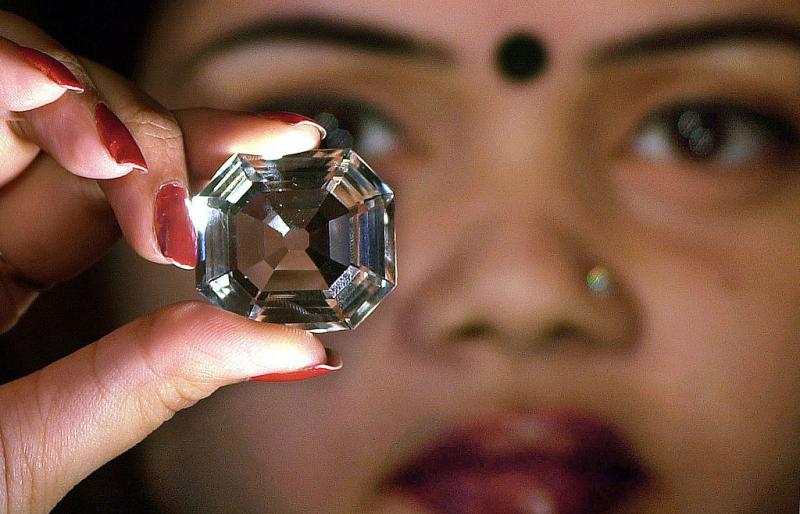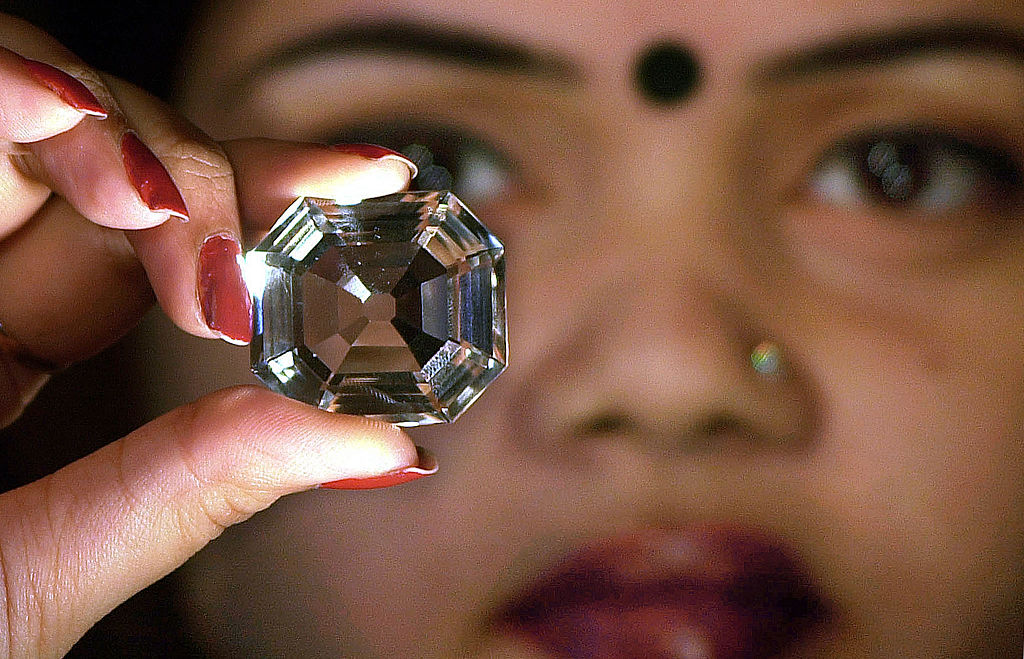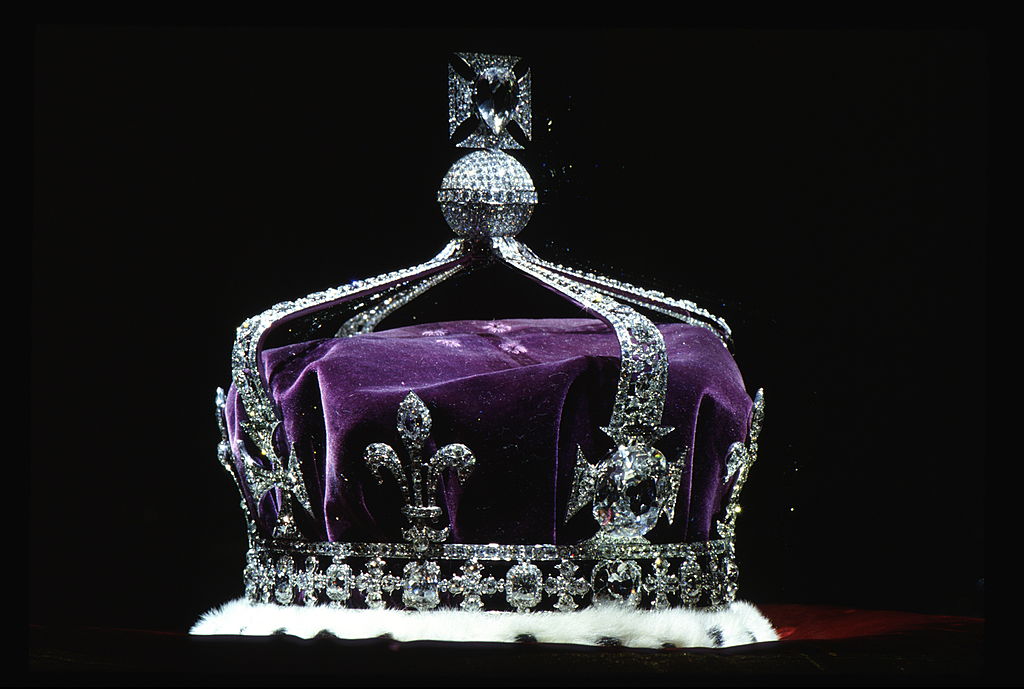With Queen Elizabeth's Death, Indians Want Kohinoor Returned | Time



 An Indian model shows a replica of the famous Indian diamond Kohinoor during a press meeting in Calcutta, 29 January 2002. DESHAKALYAN CHOWDHURY/AFP via Getty Images By Chad de Guzman September 9, 2022 7:31 AM EDT
An Indian model shows a replica of the famous Indian diamond Kohinoor during a press meeting in Calcutta, 29 January 2002. DESHAKALYAN CHOWDHURY/AFP via Getty Images By Chad de Guzman September 9, 2022 7:31 AM EDT
Shortly after British monarch Queen Elizabeth II passed away on Sept. 8, the word "Kohinoor" began trending on Indian Twitter.
It was a reference to one of the world's most famous gems. The Kohinoor diamond is just one of 2,800 stones set in the crown made for Elizabeth's mother, known as the Queen Mother—but the 105-carat oval-shaped brilliant is the proverbial jewel in the crown.
In India, it is notorious for the way in which it was acquired by the British.
The history of the Kohinoor
When it was mined in what is now modern-day Andhra Pradesh, during the Kakatiyan dynasty of the 12th-14th centuries, it was believed to have been 793 carats uncut. The earliest record of its possession puts it in the hands of Moguls in the 16th century. Then the Persians seized it, and then the Afghans.
The Sikh Maharajah, Ranjit Singh, brought it back to India after taking it from Afghan leader Shah Shujah Durrani. It was then acquired by the British during the annexation of Punjab. The East India Company got hold of the stone in the late 1840s, after forcing the 10-year-old Maharajah Dunjeep Singh to surrender his lands and possessions.
Read More: Countries May Cut Ties With Monarchy After Queen's Death
The company then presented the gem to Queen Victoria. Prince Albert, her consort, asked for it to be recut and it was set in the crowns of Queen Alexandra and Queen Mary before being placed in the Queen Mother's crown in 1937.
The Queen Mother wore part of the crown at her daughter's coronation in 1953. The Kohinoor has been among the British crown jewels since then, but governments in Iran, Afghanistan, Pakistan, and India have all laid claim to the diamond.
 The crown of Queen Elizabeth the Queen Mother, containing the famous Kohinoor diamond, pictured on April 19, 1994. Tim Graham Photo Library via Getty Images
The crown of Queen Elizabeth the Queen Mother, containing the famous Kohinoor diamond, pictured on April 19, 1994. Tim Graham Photo Library via Getty Images
Britain's controversial possession of the Kohinoor diamond
While no plans for the future of the gem have been disclosed, the prospect of it remaining in the U.K. has prompted many Twitter users in India to demand its return.
"If the King is not going to wear Kohinoor, give it back," wrote one.
Another said the diamond "was stolen" by the British, who "created wealth" from "death," "famine" and "looting."
It is not the first time that the diamond's return has been sought. Upon India's independence in 1947, the government asked for the diamond back. India made another demand in the year of Queen Elizabeth II's coronation. These demands fell on deaf ears, with the U.K. arguing that there are no legal grounds for the Kohinoor's restitution to India.
British-Indian author and political commentator Saurav Dutt says the chances of the U.K. returning the jewel are slim.
More from TIME
Read More: Why King Charles III Was an Unpopular Hei r
True, the British recently facilitated the return of the Benin Bronzes—72 artifacts looted by British soldiers in the 19th century—to the Nigerian government. But Dutt says the British royal establishment is still "married to this romantic version of empire, even though it is long dead, and has lost its power." The Kohinoor is a symbol of that power, Dutt argues, and in turning it over, he believes the Royals "would essentially be eviscerating themselves."
At the very least, King Charles III must acknowledge the "black history" of the Kohinoor diamond, Dutt says.
"A recognition of the fact that it was obtained through stealth and deception would be a significant step at this stage, that lays the groundwork for the next generation to be able to give it back," he tells TIME.
Many Indians may not have that patience. In the wake of the Queen's death, there is only one demand on Indian Twitter: "Now can we get our #Kohinoor



The Original Indian Givers?
Considering how many have laid claim to it , its apparent its history is one of possession by subjication or conquest of whomever had it .
also read that it is believed to be "unlucky" for any male royal of any creed to wear,might be better off right where it is , in a womans crown , and since it has been in the posession of the british royal family since at least the 1840s ( considering the luck they have actually had) thats likely where its better off . considering all those laying claim in that area of supposed origin, are not exactly the most "peaceful" sorts of folks .....
Might actually be cursed , like the french blue , where the hope diamond i hear origionated .
I don't see that the death of Queen Elizabeth II gives India any greater claim than existed in the first place, and in fact I think of this new demand as being quite insulting, especially when the Queen's body has hardly cooled.
That description of what happened doesnt actually sound very ambiguous.
Not a good look for Britain. They would gain more good p.r. if they gave it back.
A little island country, about the size of Kansas conquered India along with much of the rest of the world.
So what? Russia conquered some weak countries too. As did the US. Or do you think the Philippines was a worthy foe? Even the US Mexican war is generally considered to be a travesty.
You have some strange ideas.
“…conquered…”
So to the victor go the spoils. They also get to write the history, thus excusing the raping of the land, the raping of the citizenry, the subjugation of the survivors…ah, conquest.
Historically speaking, yes.
An alternative description was provided by India's previous Solicitor General Ranjit Kumar who told the Supreme Court in New Delhi it was given to Queen Victoria in 1850. " It was given voluntarily by Ranjit Singh to the British as compensation for help in the Sikh Wars. The Koh-i-Noor is not a stolen object."
Ranjit Singh was the Sikh king.
I am not well acquainted with the history of India, but a cursory internet search shows that India has usually been turbulent and violent throughout its history both pre- and post-colonial occupation.
Why has it become acceptable to cherry pick history to cause civil and political unrest?
List of massacres in India - Wikipedia
Excellent question, it will be interesting to see if you get an answer.
I hope the United Kingdom keeps it. India doesn't have any better claim to it than they do.
Keep it!
Also, Greece wants its Elgin Marbles back, too!
If you been to Athens over the last decade, you know that they would be hard pressed to keep graffiti off of them,
Like all the English graffiti that is on the pyramids?
The last time I was there public graffiti was also a big problem for Paris, Moscow, Berlin, Prague and especially London. Does that disqualify them from having custody of their own national treasures?
There are pyramids in London?
In most of Europe, there seems to be a graffiti code says that puts sculptures, historical buildings and monuments off-limits, what I saw in Athens, those were valid targets as well.
No, the Englishmen traveled to Egypt to deface the Egyptian's monuments and haul off their treasures.
In Victorian times?
Can't say who owns it, but that is a heckuva rock maybe sell it and split the proceeds?
Why give it to India? From what I read, it should not be that big a deal to them anyway. It was the Mughals who found and first used the thing in a throne and held it for a couple centuries. Then it changed hands a bunch through conquest, and was in actual possession of Indian rulers for maybe 70 years. Later, the British made it what it is. Before they cut it, it was a big, but otherwise unimpressive rock.
The True Story of the Koh-i-Noor Diamond—and Why the British Won’t Give It Back
The stone was put into its present form by the British and has been genuinely important to that culture for 170 years. Why would they give it to India?
What stealth and deception? It was seized by the conquerors. Apparently it had changed hands several times this way. Yeah, they got a 10 year-old to sign it over to them, but trust me: the British were going to get what they wanted, no matter what. Welcome to planet Earth. That’s how shit happens here.
The "no matter what" may be why they should give it back.
What does that mean and give it back to whom?
Why? That is not a reason. The British were in control. That’s the point. Several different regimes - starting with the Moghuls - controlled the diamond. The British made it what it is. Where is the Indian claim?
It does seem that the diamond should be returned.